The Samsung QN92/QN90 is a premium device that will satisfy even the most demanding users. Thanks to MiniLED technology, the television offers excellent contrast and high brightness, making movie watching an experience reminiscent of a trip to the cinema. The Tizen system ensures quick and intuitive use, significantly enhancing everyday usage. Users looking for traditional broadcasting will not be disappointed — the QN92/QN90 stands out with superb processing capability for lower-quality materials, translating to better visual experiences. The Solar Remote is an innovative addition that can take control of other devices, such as a satellite decoder, eliminating the need for multiple remotes. Notably, the 144 Hz panel provides exceptionally smooth motion, an essential feature for gamers. Additional gaming features like low input lag and the game bar make the QN92/QN90 an ideal choice for gaming enthusiasts. An additional advantage is the Auto Motion Plus Game feature, which increases image smoothness without a significant rise in input lag, making 30 frames look like 45, and 60 Hz like 90 Hz. This solution allows gamers to enjoy smoother motion without sacrificing gameplay comfort. With high brightness, multiple dimming zones, and MiniLED (Neo QLED) technology, the QN92/QN90 delivers stunning visuals during the day and at night, though slight halo effects may occasionally appear. Wide viewing angles make it a great choice for large living rooms, and the colours, supported by QLED coating, are vibrant and juicy. After additional calibration, the television presents even better quality, making its use a truly pleasant experience.
- Matching (Score)
- Our verdict
- TV appearance
- Where to buy
- Contrast and black detail
- HDR effect quality
- Factory color reproduction
- Color reproduction after calibration
- Smoothness of tonal transitions
- Image scaling and smoothness of tonal transitions
- Blur and motion smoothness
- Console compatibility and gaming features
- Input lag
- Compatibility with PC
- Viewing angles
- TV efficiency during daytime
- Details about the matrix
- TV features
- Apps
- Playing files from USB
- Sound
Samsung Neo QLED QN90D / QN92D vs TCL C7K / QM7K
Direct compare
Check the best price offer:
Samsung Neo QLED QN90D / QN92DNeo QLED / QN92D / QN90D
C7K / Q7C / MQLED85K / C79K / C71K / QM7K

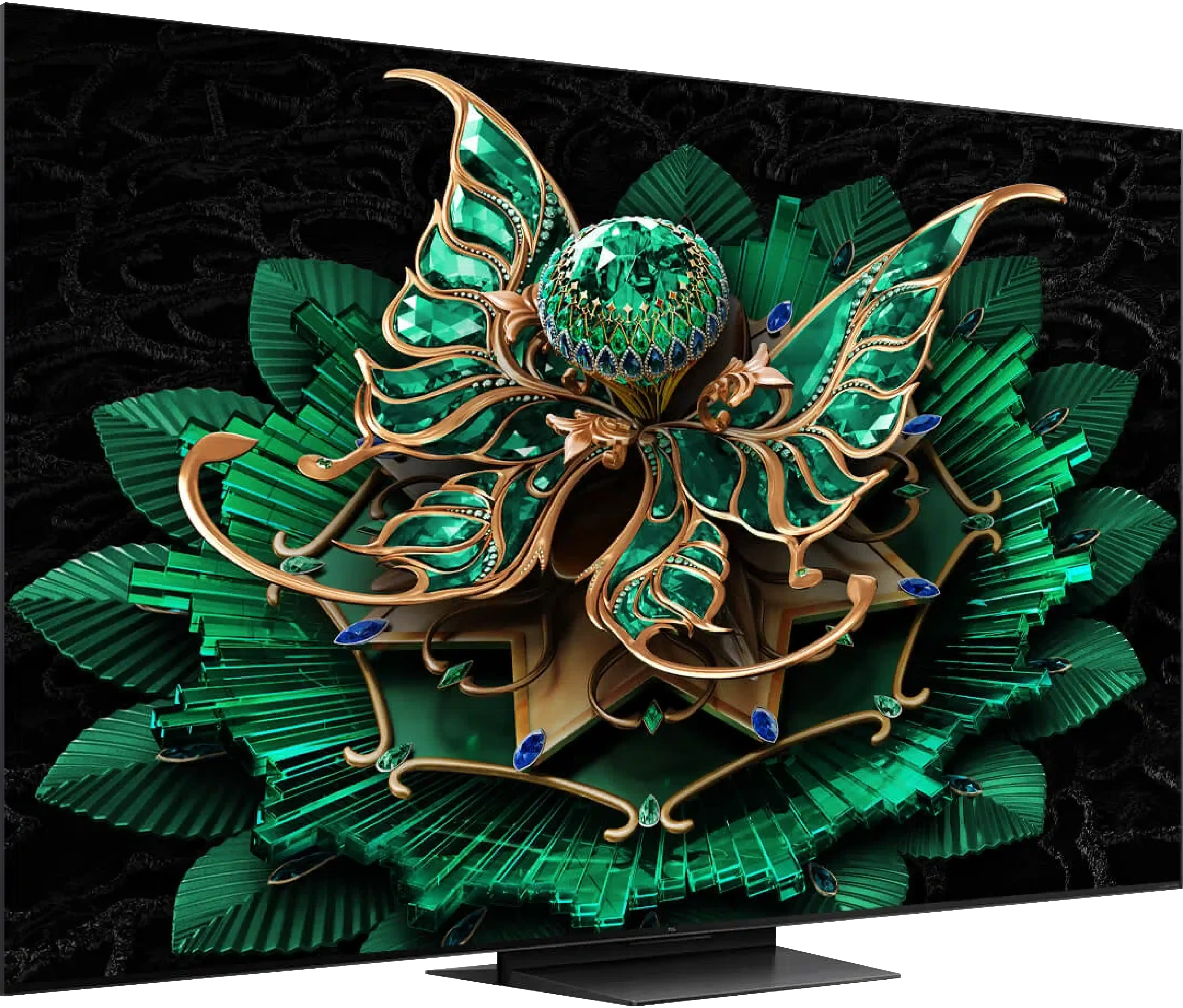
Panel type: LCD VA (wide viewing angle)
Resolution: 3840x2160
System: Tizen
Model year: 2024
Complete the survey to find out the result

Panel type: LCD VA
Resolution: 3840x2160
System: Google TV
Model year: 2025
Complete the survey to find out the result

Overall rating
7.8
7.1
Movies and series in UHD quality
7.9
6.7
Classic TV, YouTube
7.9
6.5
Sports broadcasts (TV and apps)
7.7
6.4
Gaming on console
9.1
8.5
TV as a computer monitor
8.6
8.4
Watching in bright light
6.4
6.1
Utility functions
7.7
7.7
Apps
8.7
9.6
Sound quality
6.9
7.0
Complete the survey to find out what fits your preferences
Advantages
High brightness
Good contrast
Intuitive Tizen operating system
Great for gamers and sports fans (HDMI 2.1, 144Hz, low input lag)
Wide viewing angles - unusual for VA panels
Very good black - VA panel with a large number of Mini-LED zones
High brightness in HDR - over 1000 nits
Great for gamers - HDMI 2.1, low input lag, VRR, ALLM, etc.
Good motion fluidity - 144Hz panel
Support for multiple HDR formats: HDR10, HDR10+, Dolby Vision
Google TV operating system with access to a huge app base
Pleasant sound from built-in speakers
Disadvantages
No recording feature
No DTS format support - this may be problematic for Blu-ray users
Google TV can work with minor lags
No USB recording and PiP features
Our verdict
There are TVs that come in for testing and you immediately think: "oh, another average one, probably like many others." And in fact… that's true. The TCL C7K doesn't try to dethrone the OLEDs, it doesn't shout from the box "revolution!". And yet, after a few days of testing, it's hard not to think: "wow, this is really good equipment." And that's exactly what the C7K is. The biggest asset of the C7K is its decent picture at a reasonable price – MiniLED and quantum dots do their job here. The colors are vibrant, the brightness is satisfactory, the contrast is impressive, and with the right settings, you can truly enjoy viewing in the best quality. The second strong point is the fluidity of motion – both in sports and in games. Support for HDMI 2.1, variable refresh rate, 144 Hz, and a whole bunch of other features make playing on this TV a pure pleasure. Additionally, there's Google TV, which – despite minor shortcomings – provides access to nearly an endless library of applications. Voice control, quick access to YouTube, Netflix, AirPlay support – everything you need for daily use is here. Are there any downsides? Sure. The Google TV system sometimes experiences moments of "hesitation," and MiniLED – like any MiniLED – can stumble on very challenging movie scenes. But those are details. After all, the C7K is a mid-range model – and in this class, it simply performs excellently. So if you are looking for a reasonably priced, modern TV with Google TV that looks good, works well, and sounds pretty decent without breaking your budget – the TCL C7K definitely deserves attention.
TV appearance






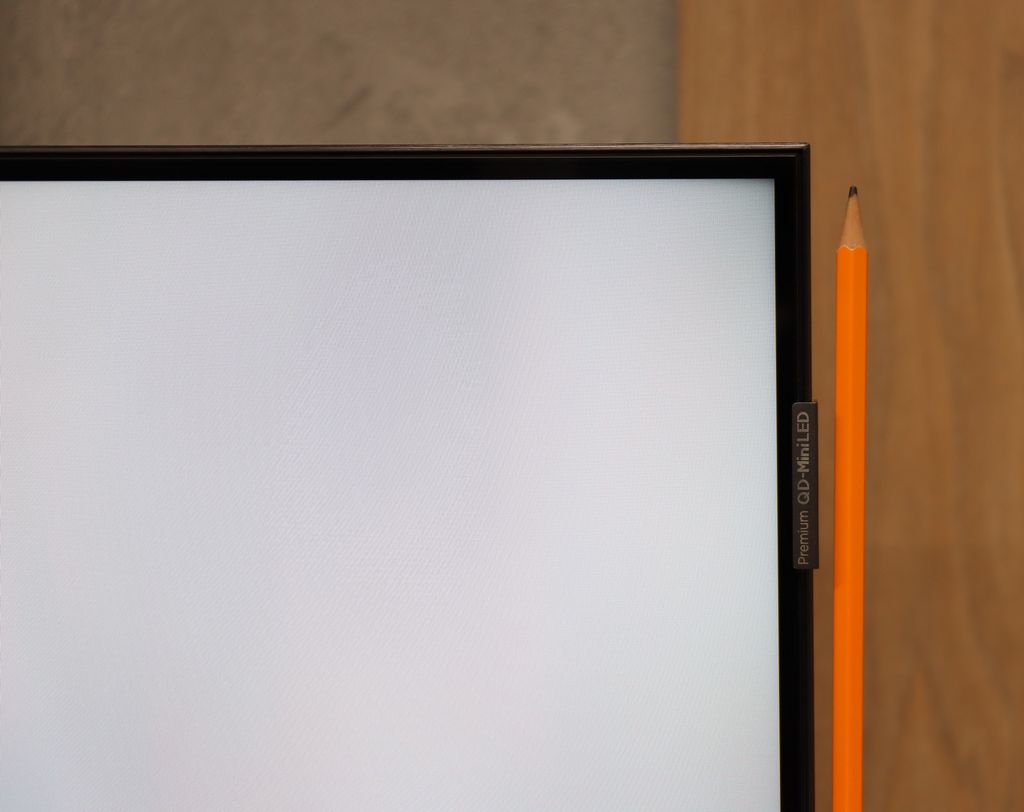
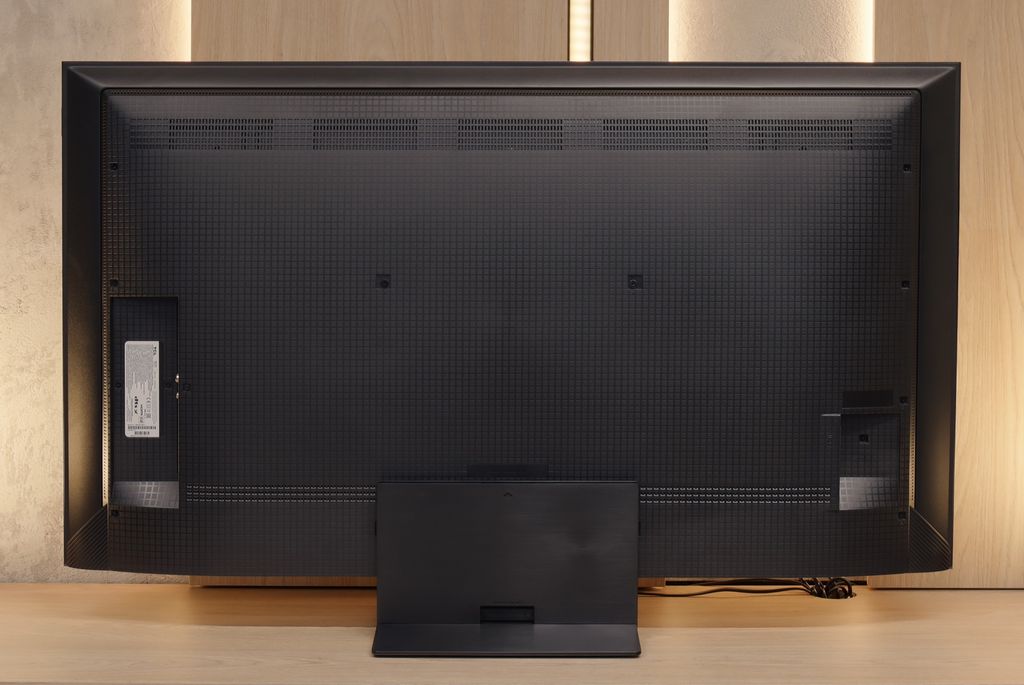
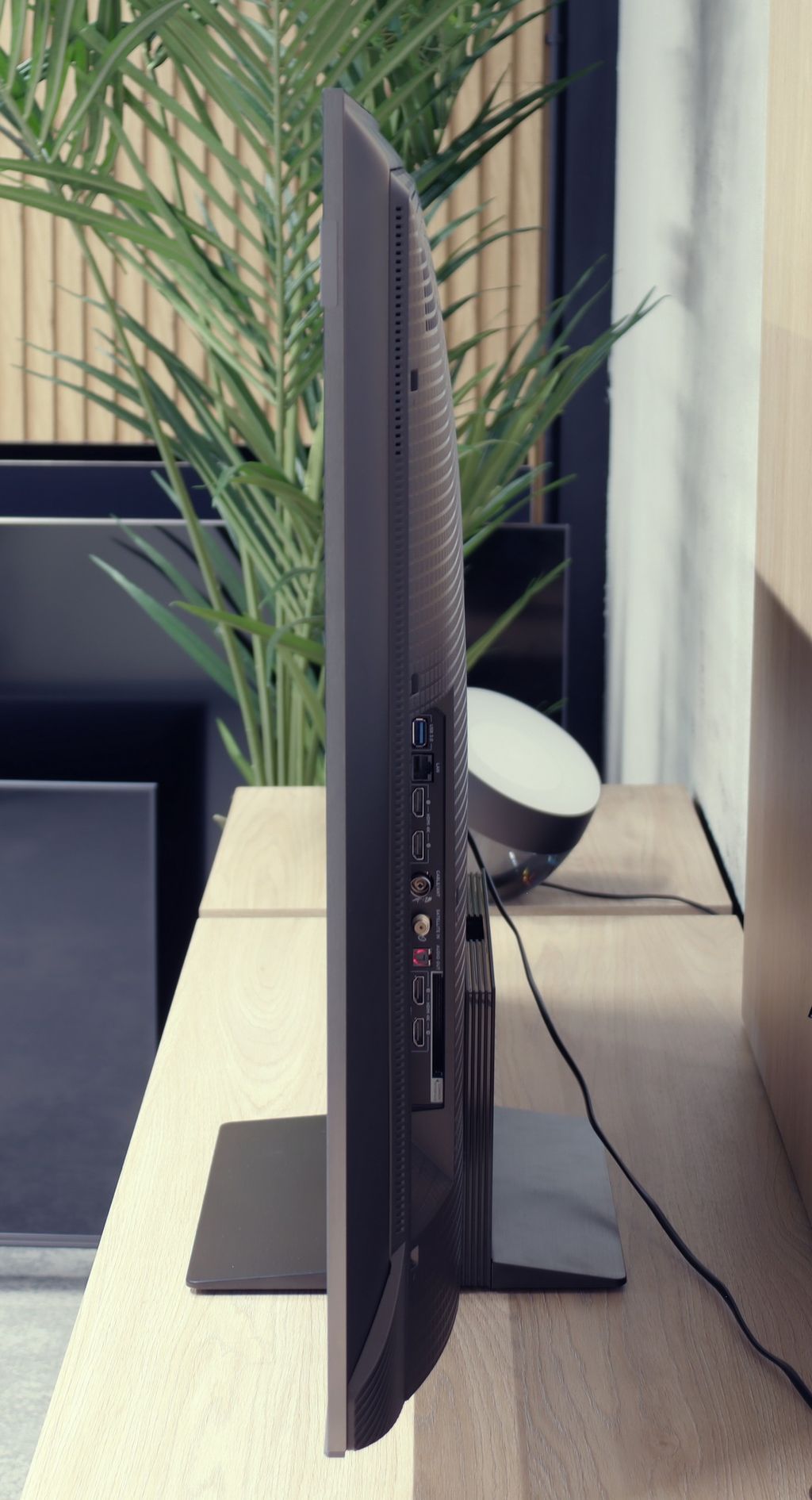
Contrast and black detail
7.9/10
7.1/10
Local dimming function: Yes, number of zones: 504 (36 x 14)
Local dimming function: Yes, number of zones: 336 (14 x 24)
Contrast:

Result
∞:1

Result
69,000:1

Result
∞:1

Result
5,500:1

Result
2,700:1

Result
161,000:1

Result
18,750:1

Result
13,150:1

Result
6,300:1

Result
4,200:1
Halo effect and black detail visibility:

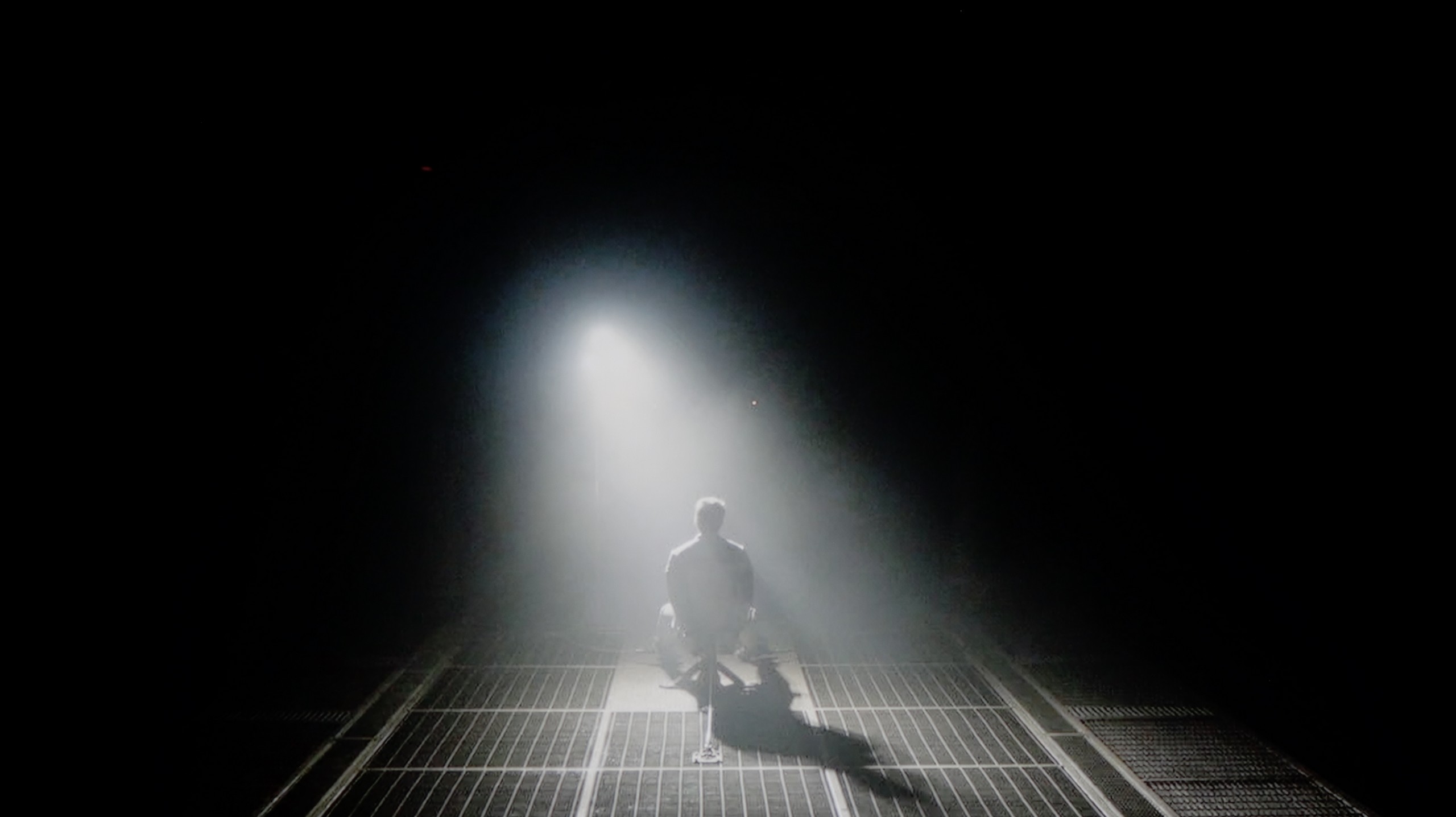
The Samsung QN92D ranks among the top models in the 2024 NeoQLED 4K (Mini LED) line from the Korean manufacturer. Although it doesn't feature as many dimming zones as its more advanced sibling, it still impresses with 504 zones in the 55-inch version. Paired with a VA panel, this setup delivers excellent contrast, making the QN92D stand out in the non-OLED category. Even in challenging scenes, such as those in Oblivion or Arrival, its near-infinite contrast can rival some of the best OLED TVs—an uncommon feat for LED-backlit displays.
However, Mini LED technology does come with limitations compared to OLED. For instance, the TV struggles with certain test patterns, likely due to its aggressive dimming algorithm. This occasionally causes the Mini LEDs to misjudge whether to highlight specific elements or maintain deeper black levels. Despite these minor drawbacks, the Samsung QN92D remains one of the top LCD TVs for contrast and black-level performance.
The 50-inch TCL C7K that we tested surprised us right from the start – it's the smallest model in the series, yet it comes equipped with a VA panel with MiniLED backlighting and – attention – as many as 336 dimming zones. For comparison: many significantly larger TVs from higher tiers would be eager to boast such a number. Here we have it in the 50-inch version. Sounds promising, right? So how does this translate into real movie-watching experiences? In the vast majority of tested scenes – very well. The contrast was so high that in measurements it even reached six-digit values, which in practice means very deep blacks and well-separated highlights. In scenes from movies like The Revenant or Oblivion, the effect was impressive, matching the best LCD screens in this class.
However, not everything went perfectly. Despite the impressive number of zones, their management was not always exemplary. In more complex scenes, where there are small light sources or a high level of detail, the TV had issues with the so-called halo effect (a glowing halo around bright objects) or with overly aggressive dimming of the image. In such situations, contrast could either collapse due to overexposing parts of the zones or, conversely – details in bright areas disappeared because the zones suppressed the light too much. Nevertheless, it's worth emphasizing that in the vast majority of scenes, the contrast was more than satisfactory. And considering the size of the TV and its price, the final effect will satisfy not just average users.
HDR effect quality
6.7/10
5.4/10
Luminance measurements in HDR:

Result
1947 nit

Result
617 nit

Result
738 nit

Result
271 nit

Result
1479 nit

Result
1051 nit

Result
185 nit

Result
454 nit

Result
200 nit

Result
836 nit
Scene from the movie “Pan” (about 2800 nits)


Scene from the movie “Billy Lynn” (about 1100 nits)


Static HDR10


Dynamic: HDR10+
Dynamic: Dolby Vision


HDR luminance chart:
TCL C7K / QM7K
Luminancja HDR
Luminance of RGB colors
Samsung Neo QLED QN90D / QN92D
Luminancja HDR
Luminance of RGB colors
During synthetic tests, the Samsung QN92D demonstrated remarkable brightness capabilities, reaching an impressive 2000 nits—on par with top models in the market. This level of brightness puts it at the forefront for displaying HDR content, where high brightness is essential. But how does it fare in real movie scenes? Under favourable conditions, such as the light-drenched opening and closing scenes of Life of Pi, the QN92D nearly replicates its lab results, delivering striking brightness levels. However, performance changes in scenes featuring small, bright objects against dark backgrounds, such as the fourth scene in Sicario. Here, brightness levels drop significantly, with maximum values capping at around 600 nits.
As with contrast, these limitations are due to the aggressive local dimming algorithm, which aims to reduce the "halo" effect around bright objects in dark scenes but often sacrifices overall brightness. Consequently, while the TV excels in scenes with abundant light, it faces challenges maintaining brightness with smaller, bright elements on dark backgrounds.
TCL C7K is one of the brightest MiniLED televisions in its price range. Under the best test conditions, the screen was able to achieve over 1200 nits, resulting in impressive, and at times blindingly bright scenes. And most importantly – this is not just a theoretical measurement. In practice, the brightest parts of movies can shine with true cinematic grandeur. Home HDR cinema fans should be truly pleased.
The impression is especially great in scenes with large areas of brightness – white skies, explosions, sun reflections, or magical sunsets can surprise with the intensity of light that rarely appears in this price range.
However, things get a bit worse when more challenging scenarios appear on the screen, which have been described in terms of contrast – meaning images full of details, with small bright elements against a dark background. In such cases, the C7K often chooses to retain black at the expense of brightness. An example? Scenes from the movies Sicario 2 or Life of Pi, where small light sources (like a distant lantern) can be less visible, and details in the lights are simply dimmed or blend into the background.
For many viewers, this may be an acceptable compromise – as we achieve deep blacks and pleasant image texture. Nevertheless, it is worth being aware that the visibility of small details in bright areas is not the strongest suit of this model. It is simply a technological limitation that still exists – even with over 300 zones.
Factory color reproduction
6.1/10
6/10


Factory Mode
After calibration
The best mode for colour reproduction on the Samsung QN92D is Filmmaker mode. Although it generally offers good colour quality, it is not without significant issues. Starting with HD/SDR image quality, the main challenge is white balance. The graphs reveal considerable instability, with a dominant red tint that makes the image appear too warm. This imbalance causes shades to shift unnaturally towards warmer tones, potentially affecting the perception of natural colours. Additionally, while contrast, as indicated by the gamma chart, is not the worst, it still falls short of the ideal, impacting overall image quality, especially in darker scenes.
This issue continues with 4K content, such as high-quality series or films. Here too, white balance proves problematic, with noticeable deficiencies in both blue and red, leading to tonal shifts. Tests using the Colour Checker tool confirm these issues, showing a tendency for colours to skew toward yellow hues, further distorting the natural look of the image. While Filmmaker mode remains one of the best options for cinematic content, it could still benefit from improvements, particularly in colour accuracy and white balance.
A new feature in TCL televisions for 2025 is the long-awaited Filmmaker mode, which until now could be found in most competitive brands. This is great news because this mode is considered the truest to the original vision of the creators and is often recommended by enthusiasts of good image quality. Unfortunately – as is often the case – the mere presence of this feature does not guarantee perfection. The Filmmaker mode in the TCL C7K is not free of flaws. One could point out the incorrect white balance, particularly the slight dominance of blue, which caused cool, somewhat grayish skin tones. But that was not the biggest problem. The main complaint was excessive brightness exposure, which is clearly visible on the gamma and EOTF graphs. The image was simply too bright, at times even blown out, which affected not only the plasticity of the scenes but also the overall viewing experience. Some details simply got lost, and the whole image looked as if someone had overdone it with the brightness slider. As always – we decided to see what could be squeezed out of it after calibration. And this is where things got really interesting...
Color reproduction after calibration
8.7/10
7.5/10

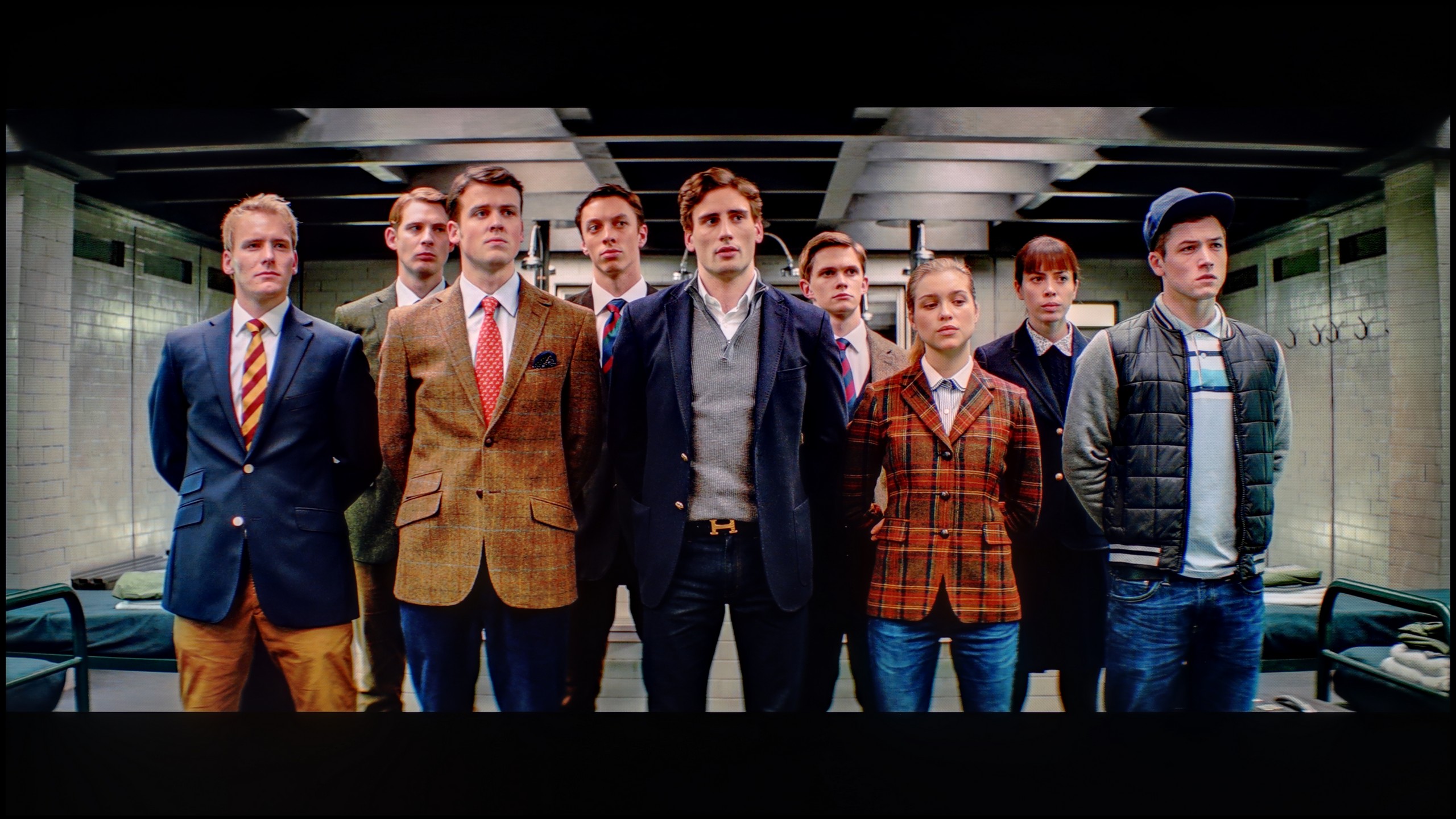

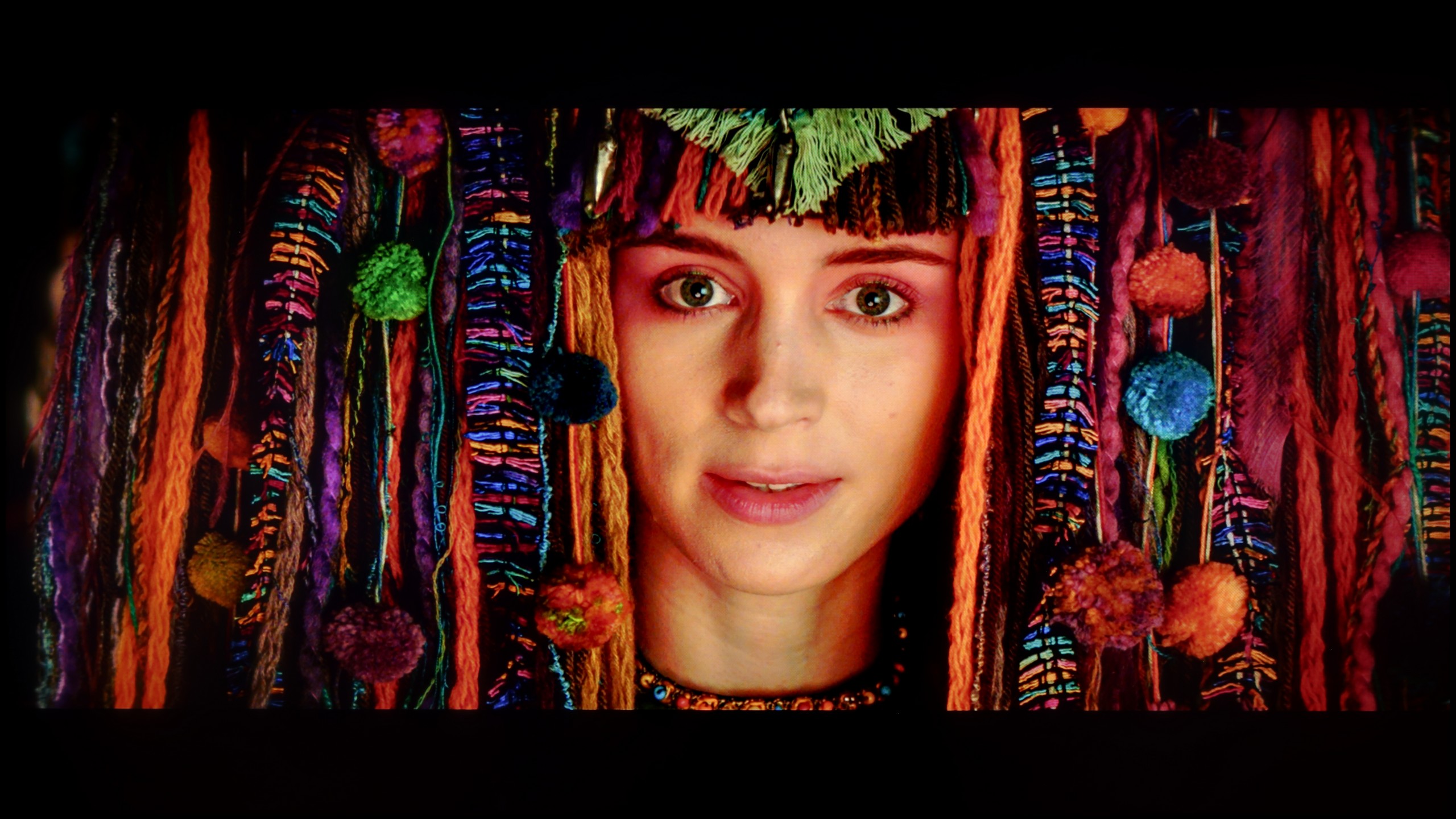
After calibration, the Filmmaker mode on the Samsung QN92D shows significant improvement, particularly with SDR content. The white balance has been greatly enhanced — previous colour shifts and red dominance have been corrected, resulting in more natural colour reproduction. Although the gamma curve didn’t require major adjustments, its stabilisation has positively impacted overall picture quality.
In high-quality materials, the white balance has also improved. However, contrast remains an area to watch. The EOTF curve initially appears accurate, but closer inspection reveals that the television struggles to maintain consistent contrast in film content, indicating further room for improvement. Despite these areas, one advantage is the TV’s colour saturation. Skin tones are rendered well, and while some colours may be slightly oversaturated, the overall effect is rich and vibrant.
Despite minor contrast limitations, the calibrated Filmmaker mode on the Samsung QN92D delivers excellent picture quality, with natural colours, making it a strong choice for movie watching.
After calibration, the TCL C7K showed itself in a really good light, especially when it comes to SDR content. We managed to fine-tune the white balance, color gamut, and brightness characteristics so precisely that color errors on the ColorChecker palette dropped below a value of 2. For the uninitiated – this is an almost perfect result, meaning that the image is very close to what the creators intended. Unfortunately, it was less impressive with 4K HDR content. Although we managed to slightly calm the white balance and correct its earlier errors, it is still evident that the TV has certain "MiniLED traits," especially in managing brightness. When we checked how the C7K performed with the EOTF curve on real movie scenes rather than just synthetic test patterns, it turned out that the screen still has a tendency to slightly brighten the entire image. This affects the overall experience – the black loses some depth, and the image becomes less contrasty than it should be. Despite these minor shortcomings in HDR content, the overall reception of materials – especially in SDR – is really very good. After calibration, the C7K can display an image that can successfully compete with much more expensive models. Good color tuning, natural skin tones, and pleasant brightness make movie sessions and everyday content viewing more than satisfactory.
Smoothness of tonal transitions
9/10
8.6/10












The Samsung QN92D television excels in the fluidity of tonal transitions, giving the image a remarkably natural appearance without visible artefacts. It performs exceptionally well in scenes with complex colour gradations, delivering smooth and uniform transitions. Competing OLED televisions in a similar price range could take note, as the Samsung QN92D provides a quality that rivals even models equipped with QD-OLED panels.
The TCL C7K handles color gradation very well – in most tested scenes, tonal transitions were smooth, and colors blended together without visible contours or artificial “blot” effects. In everyday use, it’s hard to find fault with it – the image looks natural, without irritating transitions or digital artifacts. Some limitations only appear in very dark tones – especially in a heavily muted gray palette, where the TV may struggle to reproduce ideal gradation. But this is absolutely understandable, because even many significantly more expensive models in this range simply give up. Fortunately, these situations are rare and do not significantly affect the overall perception.
Image scaling and smoothness of tonal transitions
7.2/10
5.5/10
Smooth transition function


Image without overscan on the SD signal


Let's examine how the Samsung QN92D television manages tonal transitions in low-quality materials. The noise reduction function is highly effective, enhancing the fluidity of tonal transitions even under challenging conditions. However, it’s worth noting that, as with other Samsung televisions, this feature can occasionally remove desirable elements, such as film grain, which may affect image authenticity.
In terms of digital processing, the Samsung QN92D also performs impressively. During testing, the image appeared natural and well-balanced, with details like background branches precisely reproduced, underscoring the television’s ability to enhance the quality of low-resolution materials.
The TCL C7K features a function that, according to the manufacturer, is supposed to smooth out unwanted color transitions – something like a rescue for less successful tonal shifts. It's called "Gradual Smoothing" and... well, it sounds ambitious, but in practice, it works very poorly. Regardless of whether we set it to low or high, the difference is minimal. What's worse – the function can remove elements from the image that should remain. Fortunately, film grain remains untouched, so at least it doesn't smooth everything indiscriminately, but still – it's better to just turn this option off.
As for scaling lower-resolution content, it's already better. SD and HD materials look quite decent, though sometimes we had the impression that the image loses sharpness and becomes too soft – as if something took away its clarity. Fortunately, at very low sources (e.g., 576p), there was no overscan effect, meaning the image was not artificially cropped – everything fit on the screen as it should.
Blur and motion smoothness
7.5/10
7.5/10

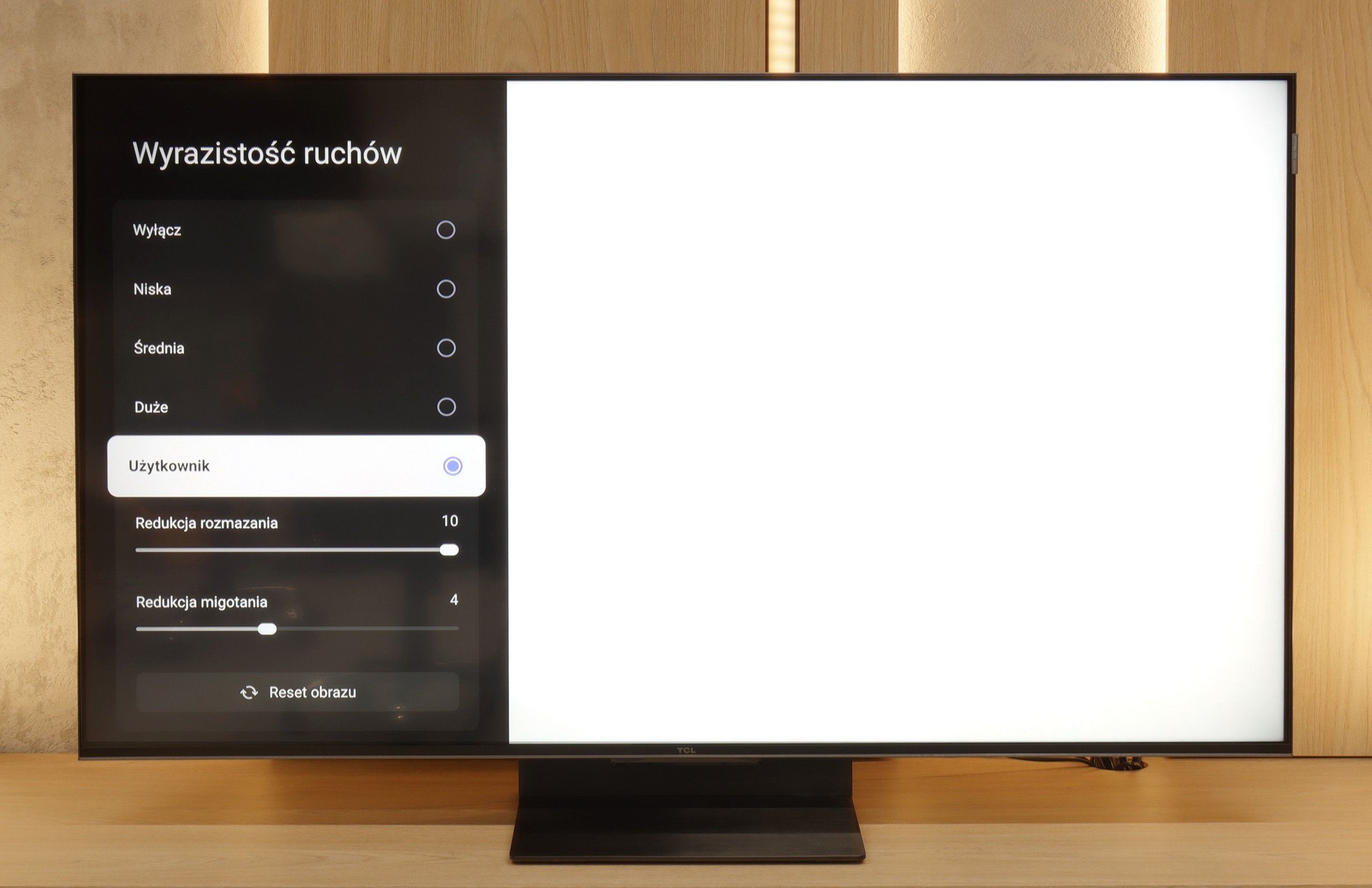
Blur (native resolution, maximum refresh rate):





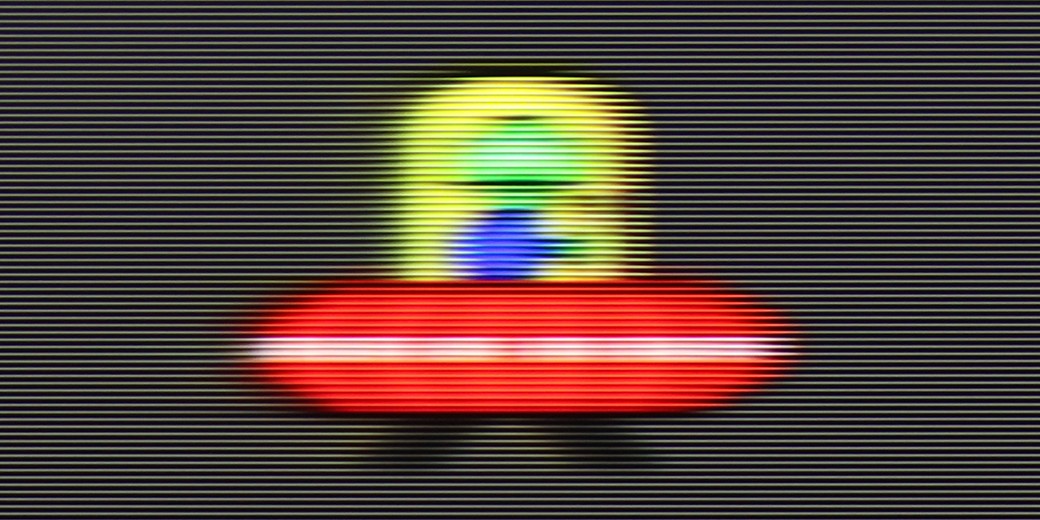
Blur (BFI function enabled):
Image flickers in this mode






Smużenie ():
Smużenie (4K 144Hz):



The Samsung QN92D TV features a 144 Hz panel, however, when using the motion smoother, the maximum refresh rate adjusts to 120 Hz. This setup ensures excellent picture quality for both gamers and sports enthusiasts. Additionally, the TV offers a range of image enhancement options, such as the "blur and judder reduction" feature, which lets users fine-tune smoothness on a 10-point scale. Blur reduction sharpens fast-moving objects, while judder reduction smooths out motion, eliminating the "stutter" effect. With these advanced settings, the Samsung QN92D provides optimal visual experiences for dynamic scenes and intense gameplay alike.
The TV performs impressively in terms of motion blur, with minimal issues. The only minor drawback is a slight overshoot effect noticeable on dark backgrounds in our "Ufoludkiem" test. Nonetheless, with its advanced smoothness settings, the Samsung QN92D delivers outstanding performance for both fast-paced scenes and immersive gaming sessions.
TCL C7K handles motion smoothness really very well. The matrix used in it offers a refresh rate of 144 Hz, which already suggests that this TV is something more than just an ordinary "60 Hz" panel. Moreover – if we connect the C7K to a computer and set the resolution to Full HD. But we will write more about this in the paragraph about gamers and PC cooperation. Returning to everyday use – both sports and movies look very good here. Thanks to the fast panel and well-functioning motion smoother, the C7K is perfect for watching matches, but also for movie screenings. In the menu, we will find two sliders – blur reduction and flicker reduction – which allow us to adjust the motion smoothness effect to our own preferences. At lower settings, we get a more cinematic effect, with slight frame motion. At higher settings – the image becomes more theatrical, smooth to the point of exaggeration. Everyone can set it to their liking.
Console compatibility and gaming features
9.5/10
9.8/10
- ALLM
- VRR
- VRR range48 - 144Hz48 - 144Hz
- Dolby Vision Game Mode
- Correct implementation of HGIG
- 1080p@120Hz
- 1440p@120Hz
- 4K@120Hz
- Game bar

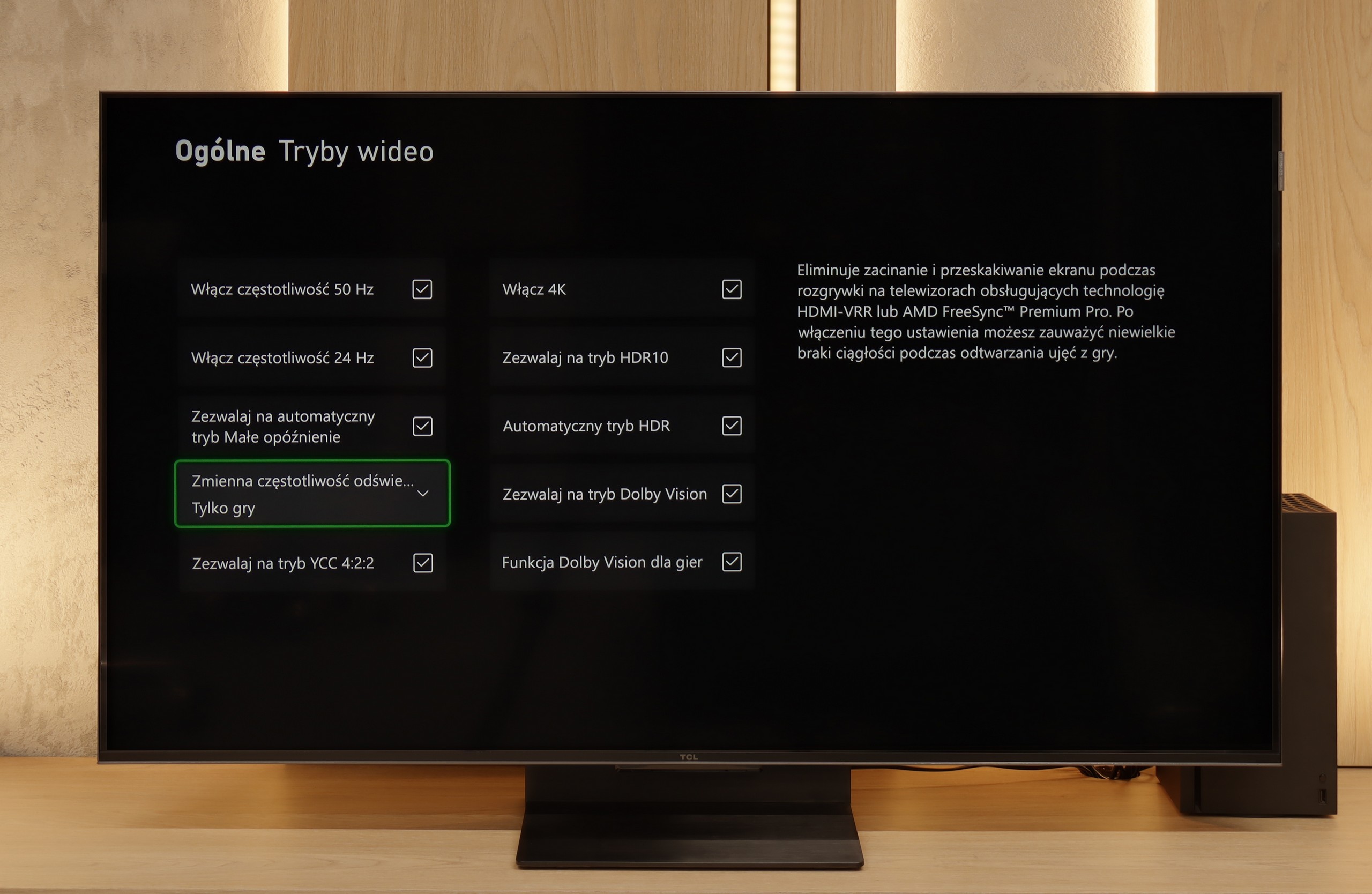

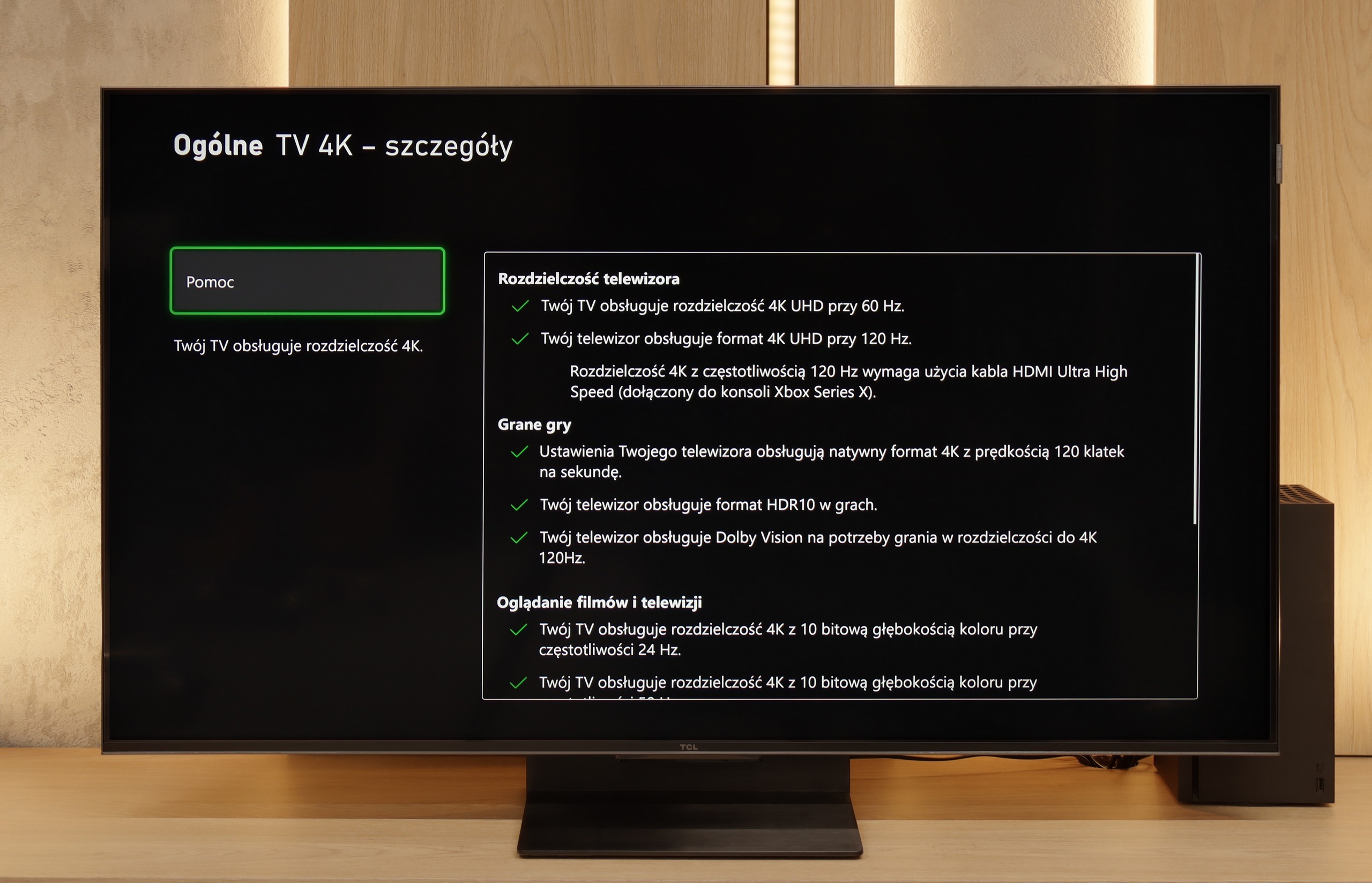

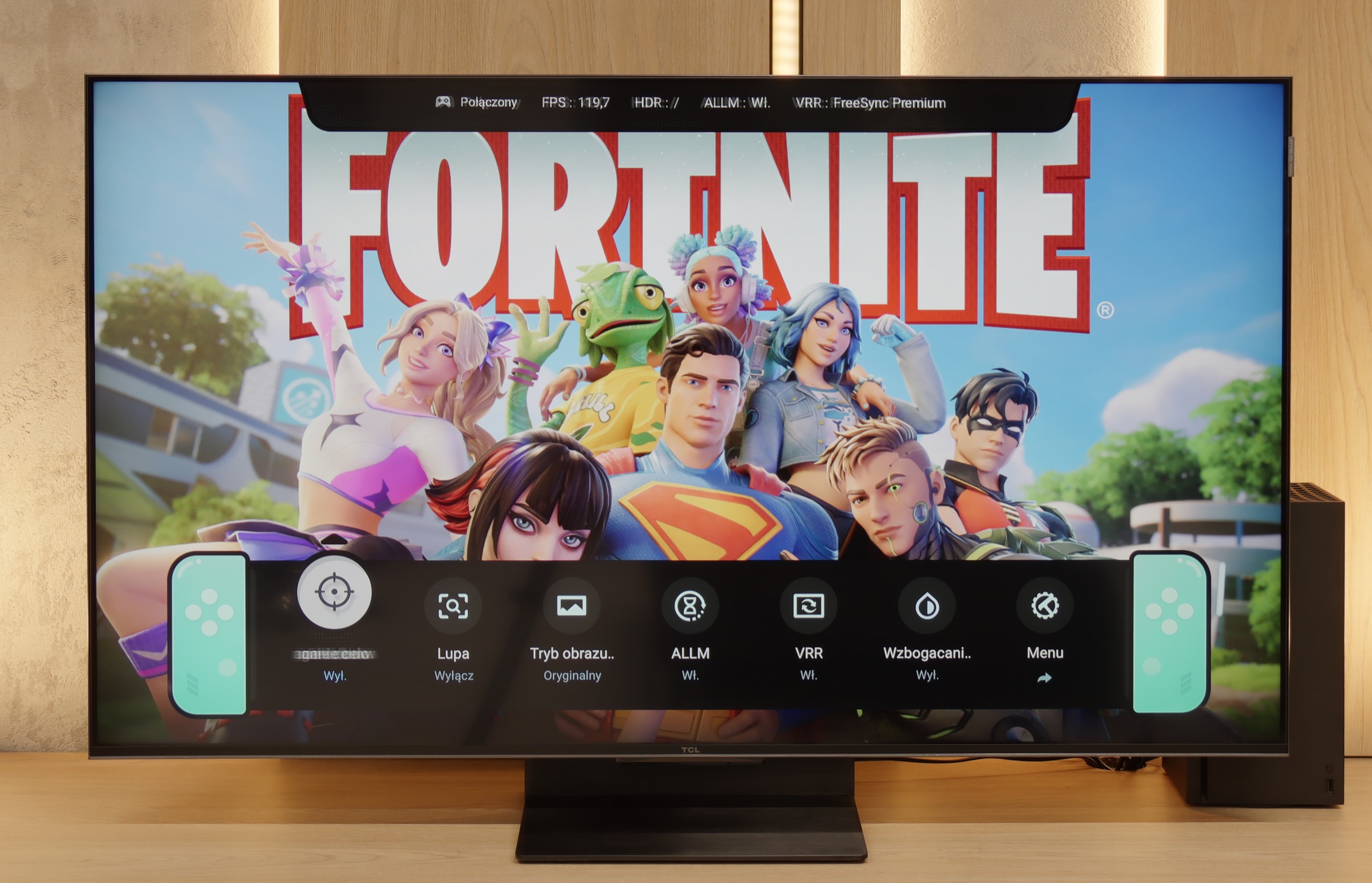

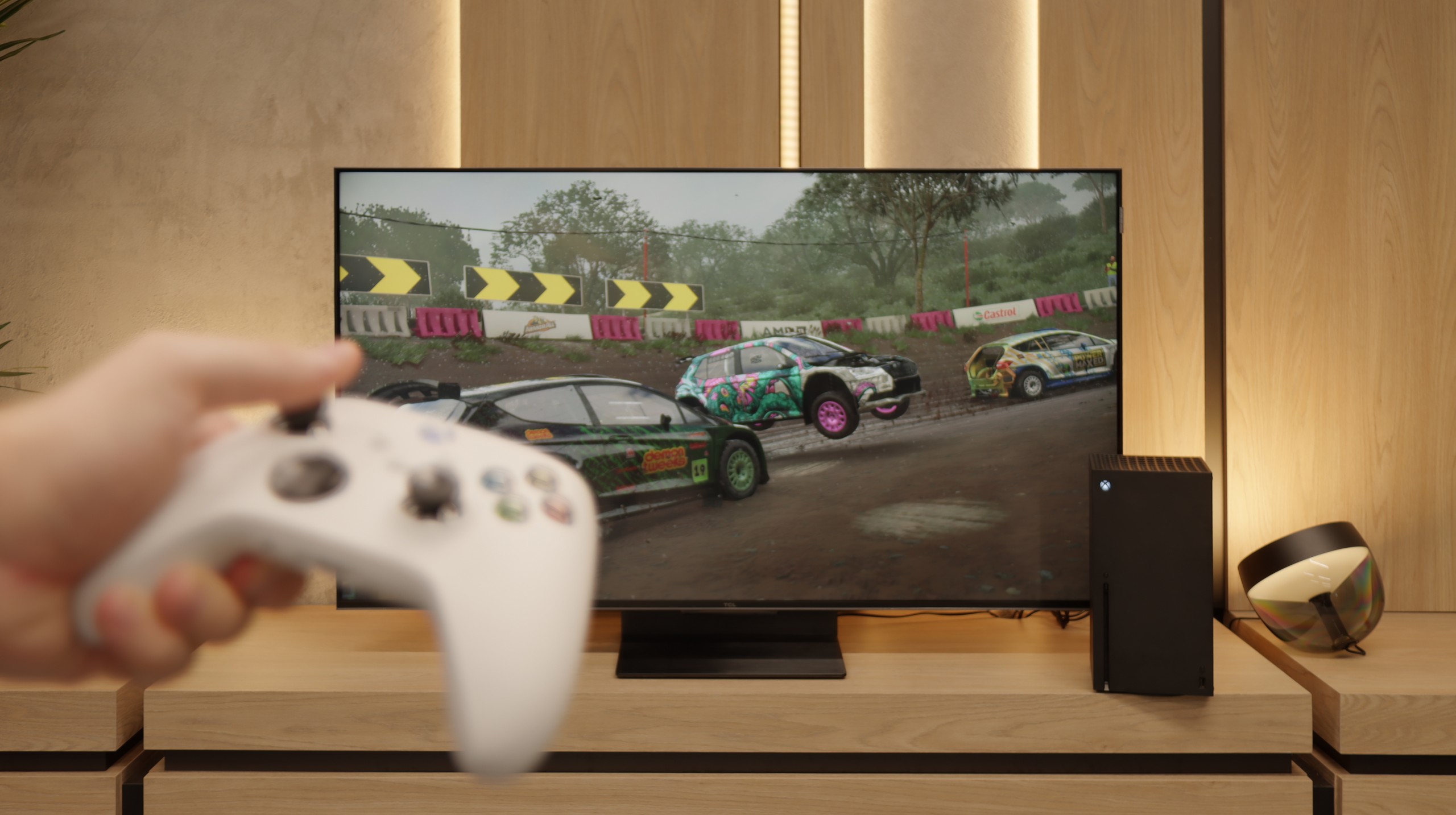
The Samsung QN92/QN90 TV is an outstanding choice for avid gamers and is highly recommended. This model provides virtually every gaming feature currently available, enhancing the excitement of gameplay. A standout feature is the 120 Hz panel, delivering impressive motion smoothness, which is especially beneficial during action-packed games. The TV also boasts low input lag, ensuring quick responses to player commands. Additionally, VRR (Variable Refresh Rate) and ALLM (Auto Low Latency Mode) optimise refresh rates and automatically activate gaming mode, further elevating the gaming experience. An additional bonus is the Xbox app, enabling users to play directly on the TV without needing a console—an exclusive feature in Samsung TVs, adding to their appeal in the gaming world.
Samsung’s Auto Motion Plus Game feature deserves particular praise. This motion smoother is highly effective in gaming, making lower frame rates appear smoother—30 frames per second can look like 45, and 60 Hz can resemble 90 Hz. Crucially, it achieves this without introducing noticeable input lag (keeping it below 25 ms), so gameplay remains highly responsive, unlike many other motion-smoothing options on the market. As a result, players can enjoy a smoother visual experience without sacrificing responsiveness.
TCL C7K is a TV that looks like the dream equipment for gamers on paper – and most importantly, it also performs well in practice. First, the good news: we have two HDMI 2.1 ports with full bandwidth, so we can easily connect both a console and a computer, taking full advantage of their capabilities. The panel itself supports 144 Hz refresh rate, which provides a significant advantage in dynamic games. Additionally, it comes with a full package of gaming features: VRR (Variable Refresh Rate), ALLM (Auto Low Latency Mode), and Dolby Vision support in games. There is also an HGiG mode, which allows for HDR effects that align with the creators' intentions. GameBar, which is an information bar for gamers. It operates quickly, looks clear (like a Nintendo console👌), and shows what’s most important: the current frame count, VRR status, and even HDR parameters.
Input lag
9.9/10
9.7/10
SDR
HDR
Dolby Vision
Input lag is a crucial factor for gamers, and the Samsung QN90D excels in this area. With input lag values below 13 ms, the delay between pressing a controller button and the on-screen response is minimal. This low value ensures smooth and responsive gameplay, satisfying both casual gamers and professionals, for whom every millisecond counts. As a result, the Samsung QN92D stands out as an excellent choice for those who prioritise precision and speed in their gaming experience.
When it comes to delays, the C7K doesn't give any reasons to complain. In games at 120 Hz, the input lag is around 10 ms, which means the television responds really quickly. Interestingly, even in Dolby Vision mode, the result is very similar, which is not always the standard. Good job, TCL. At 60 Hz, the lag obviously increases a bit, but that is completely normal and applies to virtually any television with a refresh rate of 120Hz and higher. The most important thing is that everything still runs smoothly and there is no feeling that something is not responding to our actions.
Compatibility with PC
8.6/10
8.4/10

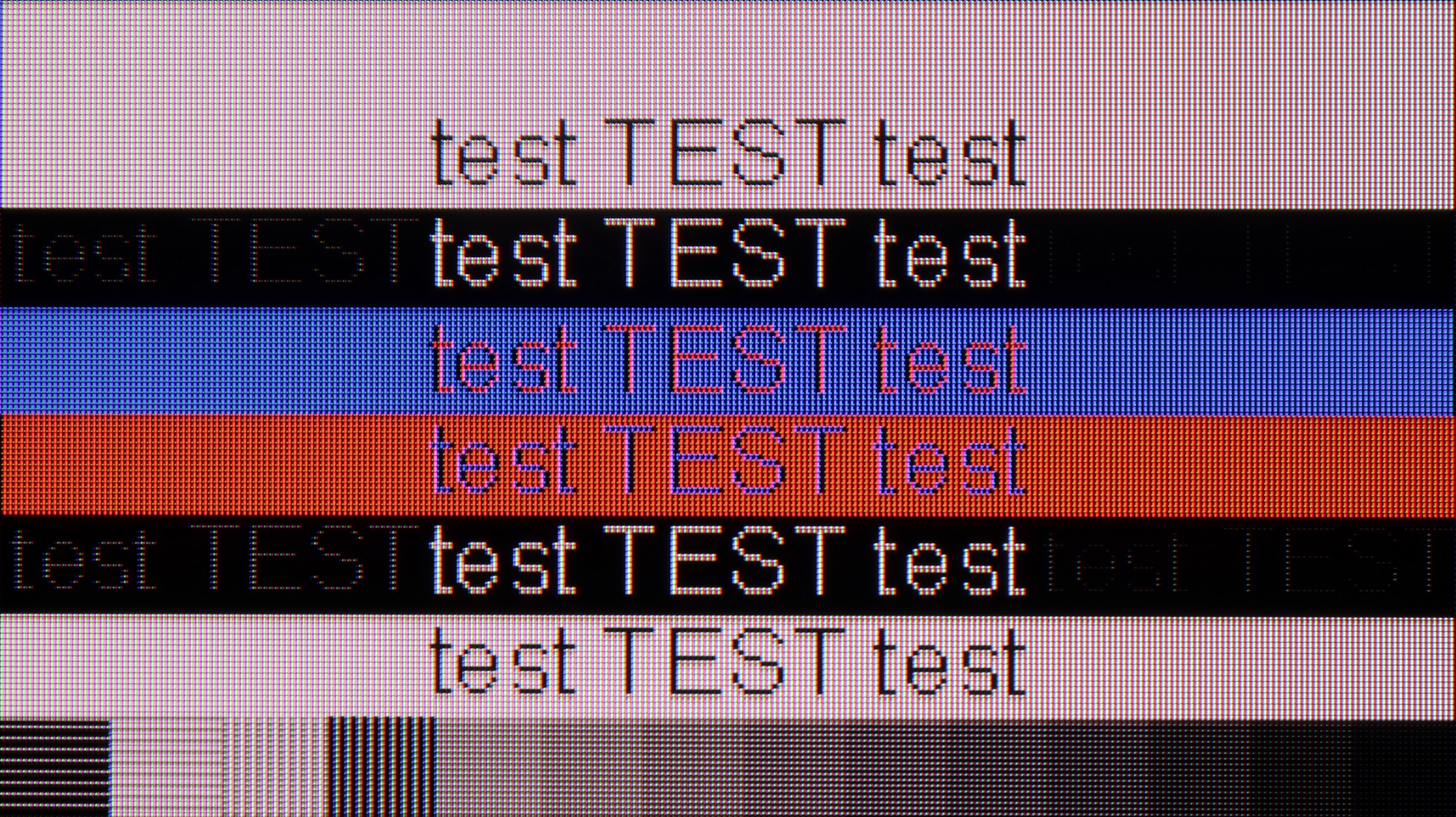
The television stands out for its high performance, supporting chroma 4:4:4 and offering exceptionally low input lag. These features allow users to enjoy fluidity and responsiveness, making it an excellent choice for office work and everyday applications. However, one notable drawback is the poor visibility of horizontal lines on a dark background. On the test pattern on the right, letters appear more like vertical lines, which can be frustrating for some users. Nevertheless, the TV generally works well with computers, providing comfort in performing daily tasks. It is also worth mentioning in this paragraph the "Remote PC" feature, thanks to Microsoft's collaboration with the Korean giant, we can seamlessly pair Windows PCs and use Office 360 applications.
If we intend to connect the C7K to a computer – especially for gaming – there’s definitely something to play with. We have 4K at 144 Hz, which sounds great on its own, but if we drop the resolution, the TV can display even 280 Hz. In e-sports, where every fraction of a second counts, this makes a real difference. On top of that, there's support for G-Sync and FreeSync, so regardless of what graphics card we have – the image will be smooth, without any stuttering or tearing.
But if we plan to put the C7K on a desk and use it like a monitor, it’s a little less “rosy.” Sure, it supports chroma 4:4:4, so fonts should be sharp, but with very dark letters, there’s a slight blurring and dimming of the edges. It’s not something that immediately stands out during gaming or watching, but when working with text – it can be distracting. In everyday use – probably without concerns, but if we plan to place a 50-inch screen a meter from our face, it’s worth keeping this in mind.
Viewing angles
7.1/10
3/10
With VA panel TVs, limited viewing angles are typically expected; however, the Samsung QN90D excels in this area. Thanks to its special coating designed to expand viewing angles, this TV delivers impressive performance rarely seen in devices with VA panels. While VA panels generally fall short in this regard, the QN90D maintains clear and vivid picture quality even when viewed from the side. This makes it an excellent choice for larger rooms and group viewing situations.
There are no surprises here – the C7K has classic viewing angles for a VA panel. That is: sitting directly in front – it’s great. Colors look good, contrast is strong, everything is in place. But just shifting a little to the side and it starts to get worse – the image loses saturation, blacks turn gray, and the overall impression diminishes a bit. So if we plan to watch together with a few people or have a couch that takes up half the living room – it’s worth seating everyone more centrally. You can watch from the side, but don’t expect miracles – that’s just a characteristic of the VA panel.
TV efficiency during daytime
6.4/10
6.1/10




Matrix brightness
Average luminance SDR
TCL C7K / QM7K: 475 cd/m2
Samsung Neo QLED QN90D / QN92D: 629 cd/m2
The TV performs excellently in bright rooms thanks to its high brightness, especially when watching standard television. A constant brightness level of 600 nits ensures excellent visibility even in intense daylight. Unfortunately, despite a satin coating, handling reflections is average, which may affect viewing comfort. An additional downside is the matrix that improves viewing angles, which causes sunlight reflections to spread vertically, potentially further reducing viewing comfort in a bright environment.
Fortunately, the TCL C7K performs quite well in a bright room. The applied matrix has a satin finish that effectively reduces reflections, so even on a sunny day, we don't have to worry about reflections from lamps or windows. Importantly, the colors maintain their intensity and do not wash out, as can happen with weaker matte panels. When it comes to brightness itself, the average for content like YouTube or regular TV is slightly below 500 nits. This is not a record result – for example, the MQLED85 (C765) performs better in this regard. However, for everyday watching during the day, it should work without major issues, as long as we don't plan to place it opposite a south-facing window without curtains.
Details about the matrix
Subpixel Structure:

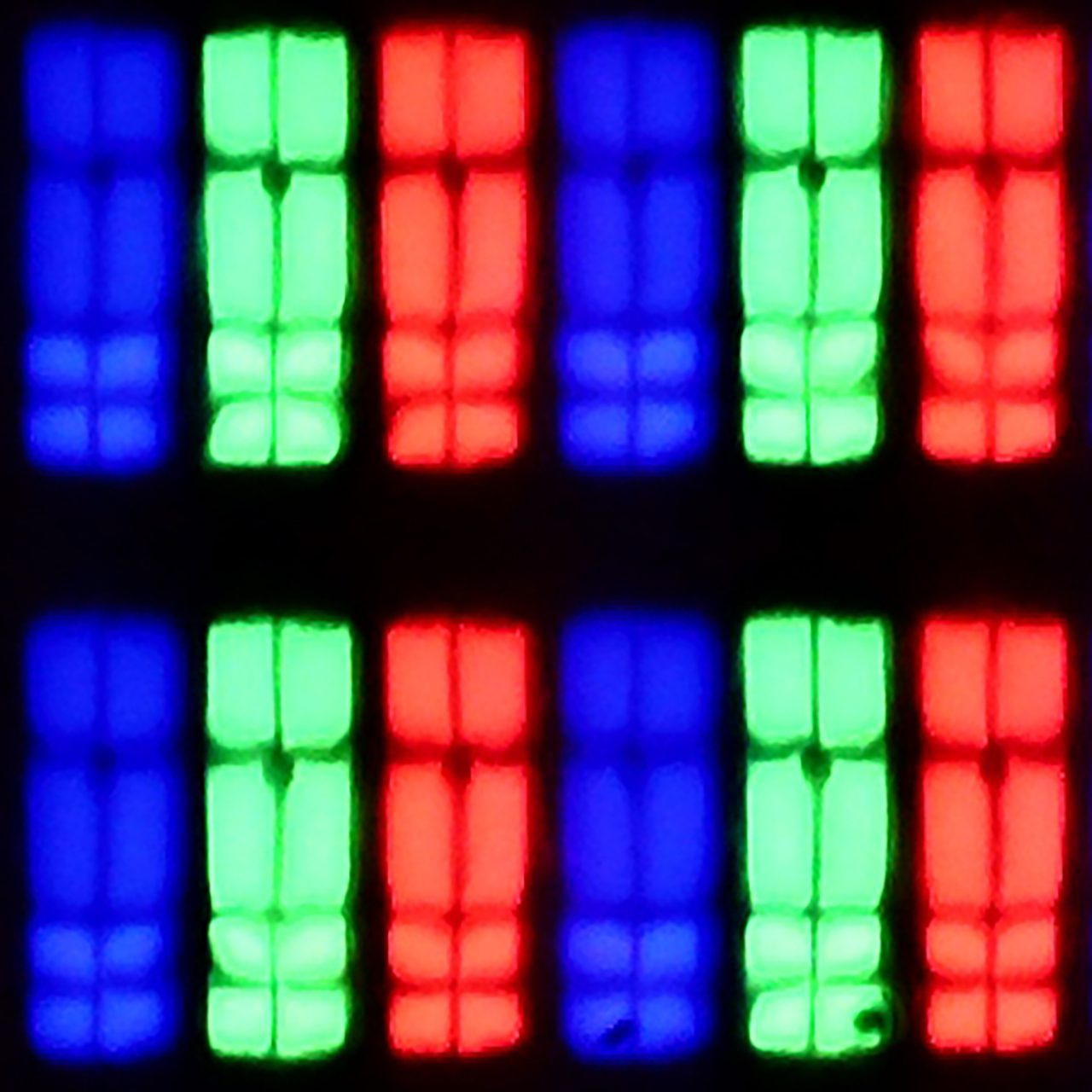
Panel uniformity:

Samsung Neo QLED QN90D / QN92D
TCL C7K / QM7K
TV features
7.7/10
7.7/10
- HDMI inputs0 x HDMI 2.0, 4 x HDMI 2.1 48Gbps2 x HDMI 2.0, 2 x HDMI 2.1 48Gbps
- OutputsToslink (Optical audio), eARC (HDMI), ARC (HDMI)Toslink (Optical audio), eARC (HDMI), ARC (HDMI)
- Network InterfacesWi-Fi 2.4GHz, Wi-Fi 5GHz, Ethernet (LAN) 100MbpsWi-Fi 2.4GHz, Wi-Fi 5GHz, Ethernet (LAN) 100Mbps
- TV receptionDVB-T, DVB-T2, DVB-S, DVB-S2, DVB-CDVB-T, DVB-T2, DVB-S, DVB-S2, DVB-C
Classic features:
- Recording to USB (terrestrial TV)
- Recording programming
- Picture in Picture (PiP)
- RF remote control (no need to aim at the screen)
- Backlit remote control
- Teletext
- Audio only mode
- Possibility to connect Bluetooth headphones to the TV
- Possibility to simultaneously use Bluetooth headphones and the TV speaker
Smart features:
- AirPlay
- Screen mirroring (Windows Miracast)
- Wyszukiwanie głosowe
- Voice search in native language
- Ability to connect a keyboard and mouse


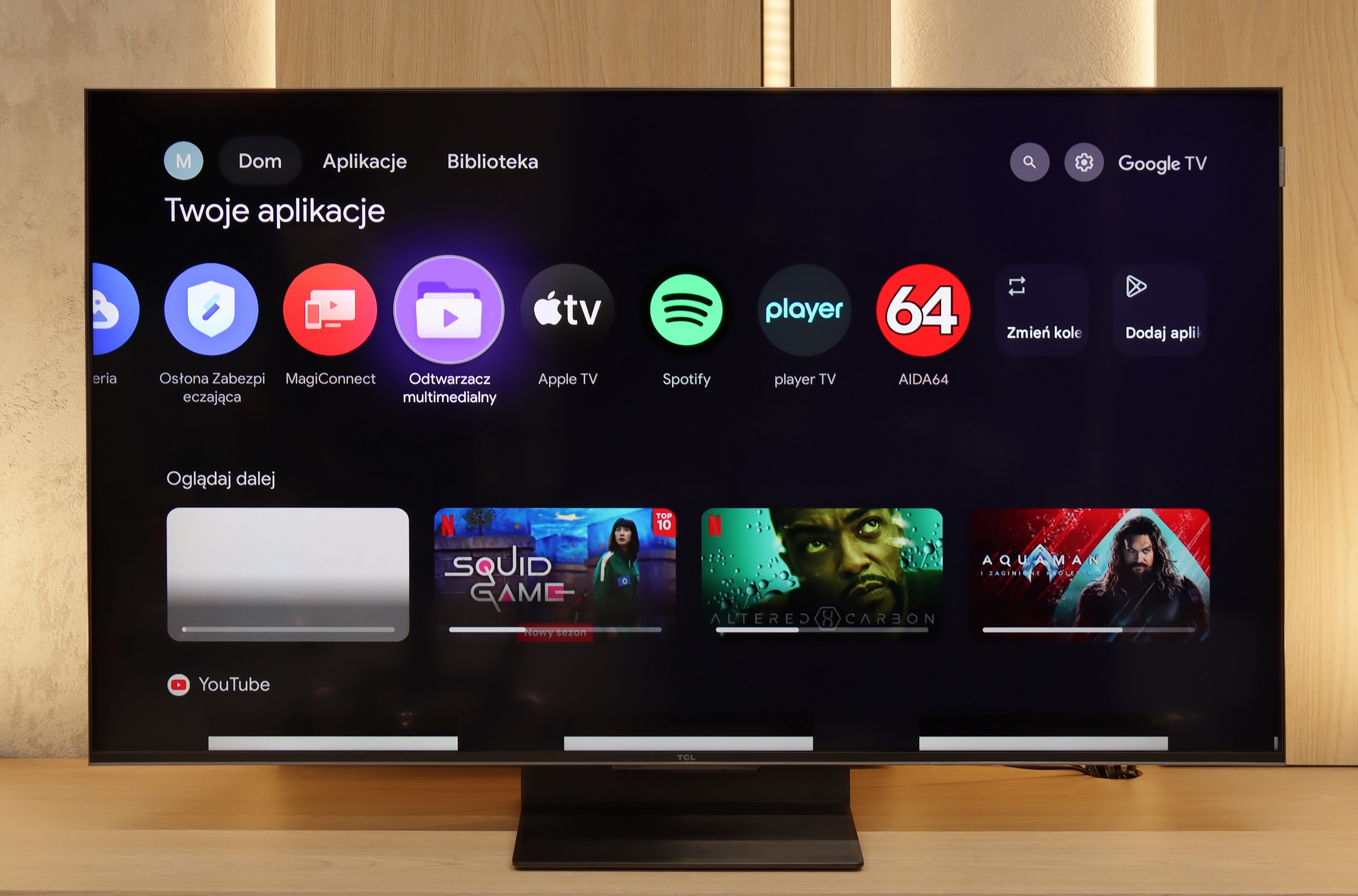
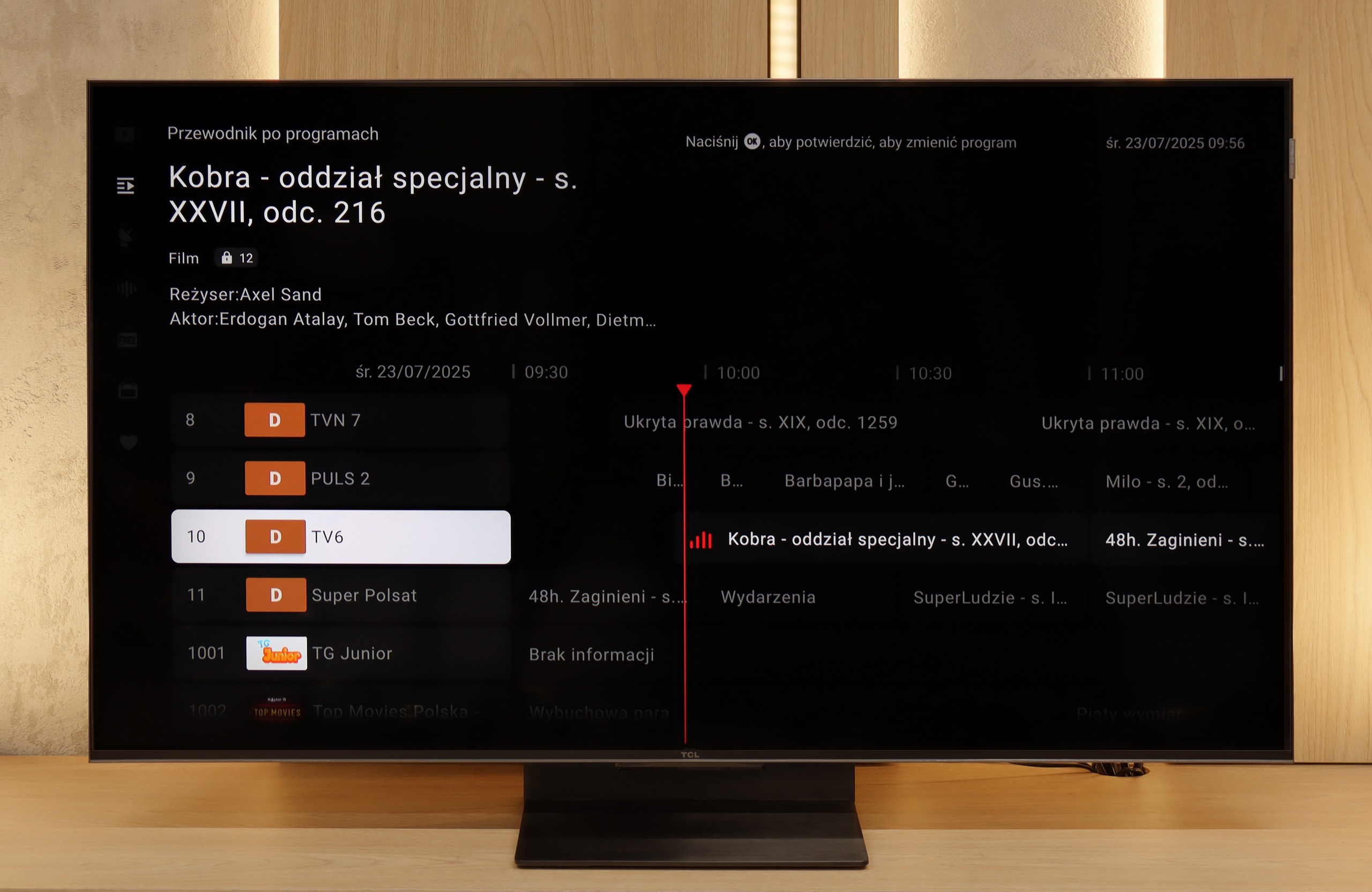
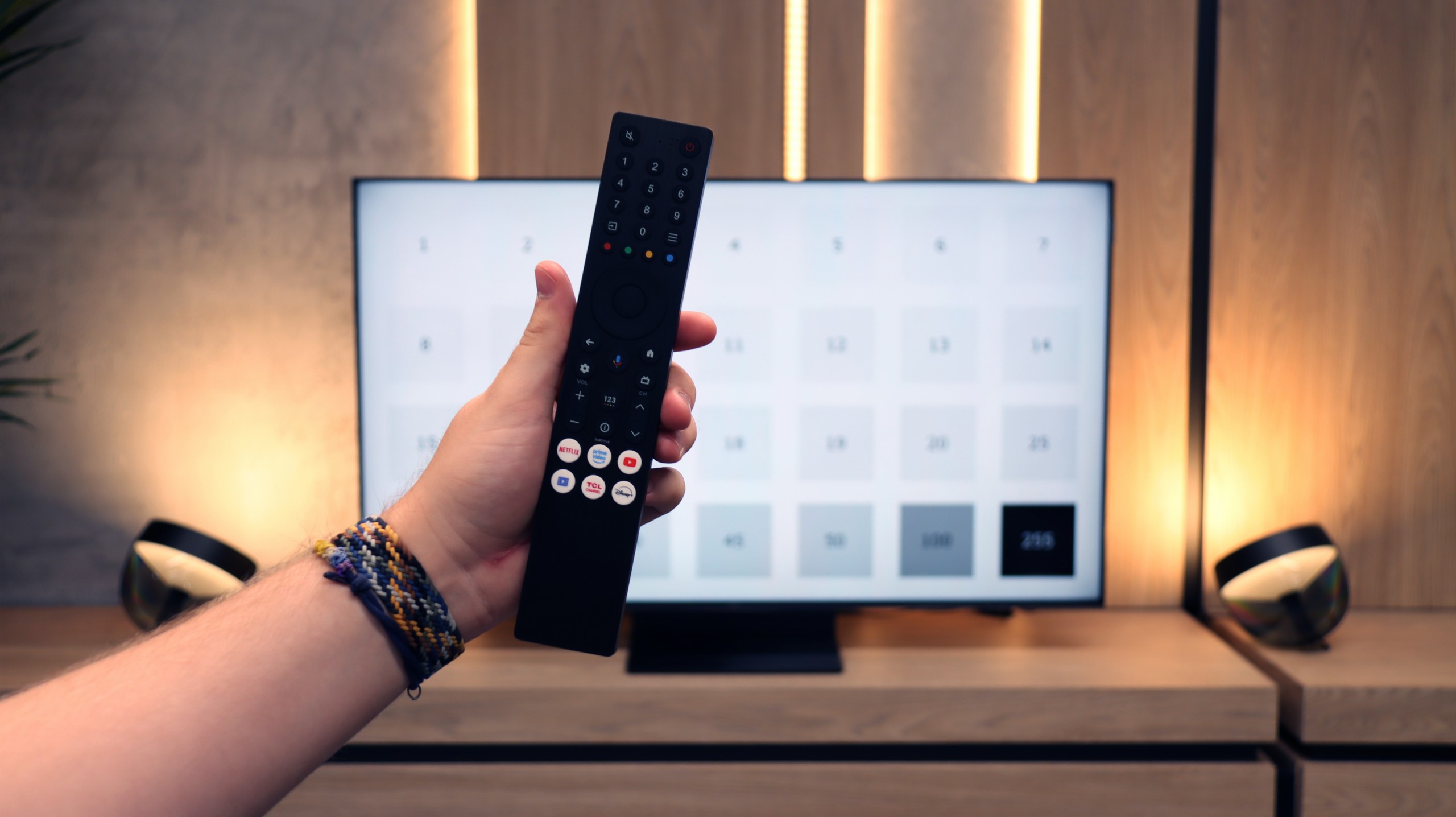
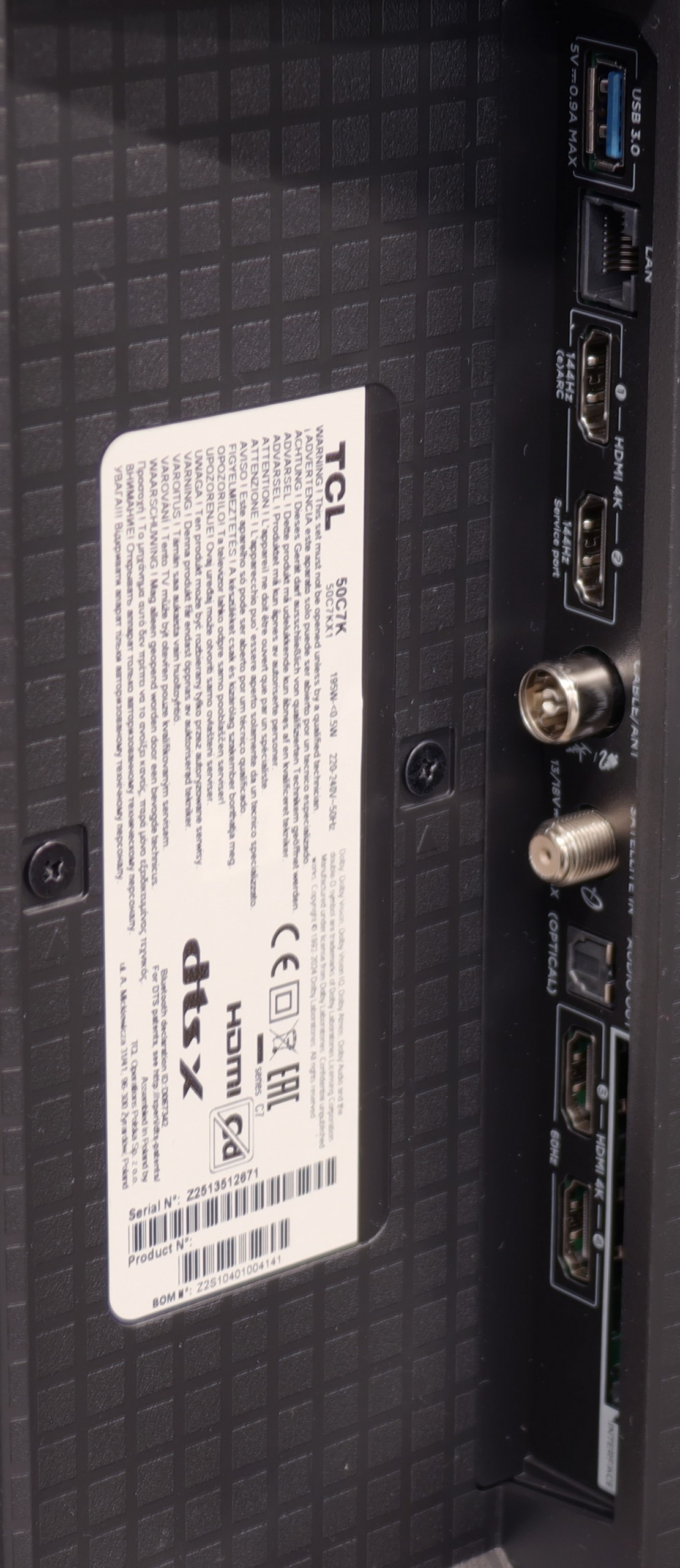
The Samsung QN92D TV impresses with its modern Tizen operating system, offering users a smooth, intuitive, and visually appealing experience. Tizen enables fast and seamless app browsing, enhancing overall ease of use. Its extensive ecosystem makes connecting the QN92D with other devices straightforward. Practical features like controlling set-top boxes with the remote eliminate the hassle of multiple remotes. Apple device users benefit from the AirPlay feature, enabling easy media streaming from an iPhone. Additionally, the remote PC function allows users to operate a computer on the big screen, and the Office 365 app makes the QN92D ideal for both work and entertainment.
Like many Samsung TVs, the QN92D includes an Ambient Mode feature, letting users personalize the display to blend with the surroundings. It can display images or information, making the TV an elegant part of the décor even when turned off. Speaking of aesthetics, the QN92D is notably slim, around 2 cm at its thickest point, with a premium-looking metal frame and a solid, included stand.
However, the QN92D may be slightly lacking for those watching traditional TV, as it doesn’t include a TV program recording feature on the Polish market. Nonetheless, it offers a PiP (Picture-in-Picture) function, allowing viewers to watch two programs simultaneously. The Samsung QN92D is a feature-rich TV that will appeal to gaming enthusiasts and multimedia users alike, seamlessly fitting into modern interiors.
SmartTV: GoogleTV
The greatest strength of the TCL C7K in everyday use is undoubtedly the Google TV system. Thanks to it, we have access to an almost endless library of apps, including more niche ones that are often unavailable on other platforms. The built-in Google Assistant understands Polish, so we can easily ask what's on TV, what the weather is like, and even give a few voice commands to control the television. It's also worth noting the presence of Chromecast and AirPlay, which work smoothly and make life easier.
Usability Features
On the downside, the classic features are somewhat lacking. Of course, we find the basics here – teletext, EPG, or the ability to connect headphones – but that's pretty much it. There's a lack of USB recording functionality or picture-in-picture (PiP) mode, which can sometimes still be found with the competition. It's also worth remembering that the Google TV implementation on TCL can sometimes have oddly translated menu sections or minor interface bugs. These are not issues that hinder everyday use, but detail-oriented individuals may notice them.
Playing files from USB
9.1/10
9.2/10
Supported photo formats:
Maximum photo resolution:


The built-in player in the Samsung QN90D should meet the needs of most users, as it smoothly plays the majority of popular video and audio formats. However, more discerning users may find a few limitations. Notably, it does not support HEIC photo format—a common format on Apple devices—nor does it accommodate several other, less widely used image formats.
The built-in media player in the TCL C7K performs really well. It supports most popular audio and video formats, so if we want to quickly throw something from a USB drive and play it – there shouldn’t be any problem. Of course, as is usually the case, there are some minor shortcomings – not every exotic codec will work (Apple's HEIC), not all subtitles will be perfectly synchronized (txt.). However, this is where the biggest advantage of this TV comes in, which is Google TV. With access to the Google Play store, we can easily install an alternative player, like VLC, and then no file is intimidating to us.
Apps
8.7/10
9.6/10














































Sound
6.9/10
7/10
- Subjective sound quality:6.9/107/10
- Dolby Digital Plus 7.1:
- Dolby True HD 7.1:
- Dolby Atmos in Dolby Digital Plus (JOC):
- Dolby Atmos in Dolby True HD:
- DTS:X in DTS-HD MA:
- DTS-HD Master Audio:
The TV shares a similar speaker setup with the QN95, configured as a 4.2.2 system with a total output of 70W (except for the 50" model, which uses a 2.2 configuration, and the 43" model with a 2.0 setup). Despite its slim design, the TV delivers a loud, clear sound with a well-balanced audio profile. As with other Samsung models, the lack of DTS format support results in a slight deduction. Notably, it includes Samsung's proprietary Q-Symphony feature, enabling seamless sound synchronization with a compatible Samsung soundbar.
To be honest, we didn't expect much from the sound in the 50-inch version of the C7K model. Usually, in such sizes, it's hard to get anything more than a thin, flat sound. But here – a pleasant surprise. The sound turned out to be really enjoyable, with good clarity and even a slightly perceptible bass. This is probably related to TCL's new collaboration with the Bang & Olufsen brand, which is new for 2025. Whether the C7K actually features original drivers from the Danish premium brand – we can't confirm. But the final effect is still deserving of a plus. For a TV without a soundbar – it sounds quite nice.


